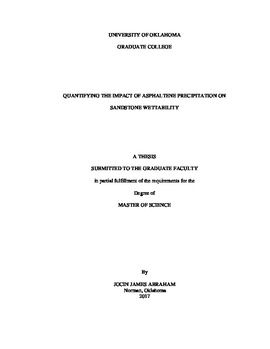| dc.description.abstract | Asphaltene precipitation, and the resulting decline in oil production, has for long been identified as a severe problem in oil reservoirs. The deposition of these high molecular weight oil fractions in pore spaces have been known to contribute significantly to permeability impairment and wettability alteration in such reservoirs. Though the phenomenon has been previously studied and documented in several laboratory experiments, many of the results are masked by the limitation of non-uniform asphaltene precipitation throughout the sample, which causes heterogeneities making many of the macroscopic measurements very hard to analyze. As a result, the deposition phenomena in reservoir rock and its impact on rock characteristics and fluid dynamics is still not well-understood and this is the focus of our study.
The development of an experimental workflow to create a uniform deposit of asphaltene inside the core sample is the base line of the initial experiments. This deposit is introduced either through injection of a crude, vacuum saturation or injecting a mixture of heptane and crude. Rock samples from Berea sandstone are prepared and exposed to Texas crude. The deposit uniformity is assured through localized Total Organic Carbon (TOC), permeability and density measurements. The impact of this deposit on the rock wettability is then quantified by measuring the relative permeability endpoints for a brine-oil system in addition to imbibition tests. Wettability alteration is then evaluated, and the results are analyzed in terms of its impact on well operations.
The results show that injecting oil or a heptane-oil mixture results in a non-uniform deposition of asphaltene, which was quantified using the TOC and absolute permeability measurements. Full exposure to crude oil was obtained through vacuum saturation where the asphaltenes is deposited uniformly. Deposition of asphaltene molecules, and the subsequent alteration of rock characteristics is evident from the imbibition results where a reduction in both the water imbibition rate and capacity is reported. In addition, the reduction in the absolute permeability could be up to 20% in cores experiencing asphaltene deposition. Core floods results conducted on the exposed rocks indicate a change in the wetting phase properties, with the exposed rocks becoming more mixed/intermediate wet, which is different in the case when the brine saturation is introduced initially to the rock. This in turn impacts the relative permeability of the rocks, and a shift in the end points of the relative permeability curves is noticed. Incorporating this new data in a simulator indicated a disparity in the modeled results before and after accounting for asphaltene deposition.
A workflow was established to achieve uniform deposition of asphaltene in the rock so that enables reliable quantitative measurements of the impact of this deposition on rock characteristics and wettability. Experimental data indicate that there is an alteration in both rock characteristics and relative permeability, and this could be severe and permanent in some cases. | en_US |
